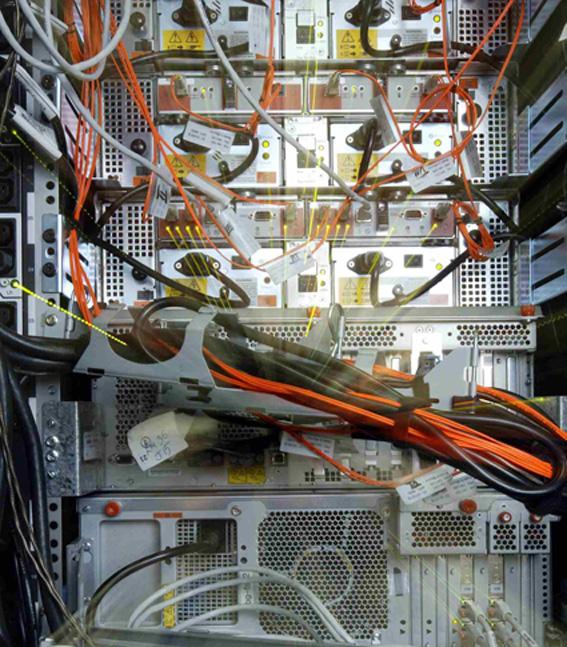Information and Computing Technology is Essential to the HBP

© BBP/EPFL
Neuroinformatics, brain simulations or supercomputing, these are research areas that are dear to Professor Anastasia Ailamaki directing the Data-Intensive Applications and Systems Laboratory (DIAS) of the School of Computer and Communication Sciences. Recently nominated co-director (with Prof. Richard Frackowiak) of the Medical Informatics Division and a workpackage leader in the High-Performance Computing Division of the Human Brain Project (HPB), Prof. Ailamaki describes the challenges that await her.
Professor Ailamaki, Information and Computing Technology is essential to the Human Brain Project. Why? “The Human Brain Project‘s purpose is to make its way through the labyrinth that is the Human Brain with its neurons and the interactions among them. The neuroscientists’ goals include understanding the mechanisms of cognition, generating unique biological signatures for diseases, and inspiring new effective cures through a better understanding of currently incurable illnesses.
“The Human Brain Project‘s purpose is to make its way through the labyrinth that is the Human Brain with its neurons and the interactions among them. The neuroscientists’ goals include understanding the mechanisms of cognition, generating unique biological signatures for diseases, and inspiring new effective cures through a better understanding of currently incurable illnesses.
Computer science is the connection between the project definition and its goals, and as such it is the unifying force which will make the project’s goals reality. Knowledge in the project will be possible through efficient collection and storage of unprecedented quantities of data, and its extensive analysis and mining. We must invent new data analysis methods to dig deeper than ever in the vast amounts of data collected form detailed brain simulations, and new data deciphering and mining algorithms as well as image processing technologies to understand patient data available from hospitals around and beyond Europe. In addition, new data integration methods need to be devised to combine all different types of data together into a unified knowledge source, which will be usable by neuroscientists and medical doctors around the world.”
Could you explain your team’s role in the Medical Informatics and the High-Performance Computing Divisions?
“My team is coordinating the Exascale Data Management technologies needed to transform all data collected in the project to useful information by neuroscientists, doctors, and practitioners using the HBP platforms. In the Medical Informatics Division, we are responsible for the development of a federated hospital network which will efficiently process data across many different hospital sites in order to answer medical questions while preserving privacy and anonymity of medical data. In the High-Performance Computing division, we develop algorithms to navigate through vast amounts of brain simulation data while using state-of-the-art supercomputers. The technology we will develop in these two divisions will be of use to other divisions in the project, as most of them are required to solve similarly daunting data management tasks to reach their goals.”
 If Information and Computing Technology is crucial to understand the brain, could Computer Science benefit from the study of the architecture and circuitry of the brain? How?
If Information and Computing Technology is crucial to understand the brain, could Computer Science benefit from the study of the architecture and circuitry of the brain? How?
“The brain’s computational model is an exquisite paradigm of time-effective and energy-efficient computation. The brain has a tremendous ability to parallelize, and solve difficult problems while performing seemingly redundant computations, while consuming energy equivalent to a banana! There is a division in HBP on Neuromorphic Computing, which targets constructing computing machines based on the principle of neural networks.” The BlueGene/Q was recently launched. This computer can perform 172,000 billion operations per second. With low energy consumption, it is counted among the Top 10 eco-friendliest supercomputers in the world. Would such high performing engine satisfy the demands of brain models and simulations?
The BlueGene/Q was recently launched. This computer can perform 172,000 billion operations per second. With low energy consumption, it is counted among the Top 10 eco-friendliest supercomputers in the world. Would such high performing engine satisfy the demands of brain models and simulations?
“Brain simulations and processing are compute-intensive, and certainly such a platform is enabling faster computations and more extensive simulations than its predecessors, but only for a small part of the brain. To really meet the goals of the HBP, however, a computer at least 5000 (five thousand) times as powerful has to be designed and built.”
The Human Brain Project is a buzz. Would it be a golden opportunity to emphasize leading roles that women undertake in science?
“Many women are excellent scientists and engineers, and I view the HBP as a great opportunity to overcome social drawbacks and superstitions and allow the world in general (and Europe in particular) to explore the female scientists’ full potential. Speaking particularly of computer science in the context of HBP, which targets such an extremely important application domain, will hopefully attract more female computer scientists to work with us.”